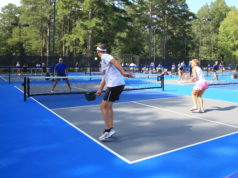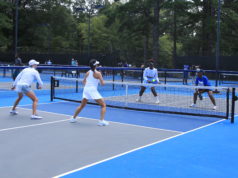SCORE IS ODD, SO SWITCH
The tiebreak always seems to present a few questions, even for those experienced players. One that seems to come up regularly is changing sides at the end of the tiebreak and who serves. Can you please give us some helpful pointers?
Celia Sheridan, Junior Leagues Vice President
The tiebreak is played when game scores are 6-6. The tiebreak is the deciding “game.” You always switch on the odd games total, so the final set score for that set is 7-6, which is odd (13 games), thus you change sides from the sides you were on at the end of the tiebreak. You will always change sides at the end of the tiebreak. As far as the server goes, an easy way to remember who serves first in the next set is to determine who served first in the tiebreak. The opposing team serves first in the new set.
This information can be found in the Adult Leagues Captains’ Handbook (page 45) on the website, altatennis.org, under Quick Links>League Documents.
_______
CONSISTENCY IS THE KEY
Another team was playing on soft/clay courts and opened hard court balls. The visiting team said you had to play with soft court balls. Is that required?
Holly Underwood, Sunday Women Vice President
The USTA Code has the list of tennis ball specifications on Page 19, Appendix I, in the 2016 Friend at Court. On page 50, F.1., it states that the type of ball used shall be consistent throughout a tournament event unless the playing surface or conditions are changed. I interpret that to say that the balls used throughout an individual meet should remain consistent and all five lines should play with the same type of ball, whether it is heavy duty felt or regular duty felt.
_______
A REPEAT QUESTION WITH A REFINED ANSWER
During our past season a team contacted our captain to request we play a couple of lines early. We accommodated the team and played lines 1 and 2 earlier in the season. The day before our regularly scheduled match, the opponent captain contacted our team to request that we begin the match at 10:30 a.m. It seems her lines 3 and 4 could not arrive by the regularly scheduled time of 9:30 a.m. These players were normally scheduled to start in the second timeslot and had made no arrangements to start any earlier. Since we were only playing 3 lines would it have been OK to start our match at 10:30 a.m.?
Joyce Vance, First Vice President
The answer to your question is listed in the Captain’s Handbook (page 41), Rule IV.E. Playing Match Early. When captains agree to play line 1 early without the agreement on times for the remaining lines, the default time for line 3 is twenty minutes after the normally scheduled time for line 3.
_______
THE SWITCH IS ON
Starting the third game of the first set, I noticed after my first serve, which went into the net, that my opponents had switched sides of the court at the start of that game. So, the wrong person was receiving. I brought this to their attention and asked them to return to their proper side. They said the rule was to play out the game and then switch back. Who was right?
Jane Milton, Thursday Women Vice President
In most cases in tennis, errors are corrected immediately. Receiving is different. This is covered in USTA Rules of Tennis, Rule 27e Correcting Errors. If the error is discovered during that game, the receiving order remains as altered until the conclusion of that game. The partners then would resume the regular order of receiving in their next receiving game. Remember, all previous points stand when this occurs. Partners are allowed to alter receiving order at the start of every set.




